The Common Octopus, also known as the Octopus Vulgaris, is one of the most widely studied species of octopus due to its widespread distribution and ease of maintenance in captivity. These cephalopods are known for their remarkable intelligence and problem-solving abilities, which have made them popular subjects for research in fields such as neurobiology and animal behavior.
This fascinating creature is found in the Atlantic Ocean and is a popular subject for marine biology research. Its unique abilities, such as the ability to change color, texture, and shape, and its remarkable intelligence make it a subject of great interest to scientists and ocean enthusiasts alike.
Have you ever wondered why the common octopus is so intelligent? Or how can they change color and texture so quickly? Let’s dive deeper into the fascinating world of the common octopus and discover the secrets of this remarkable creature. Are you ready to embark on this exciting journey with me? Let’s go!
About Common Octopus – A Quick Biology
Unleashing the mysteries of the ocean: Discover the exceptional biology of the “Common Octopus”:
| Parameters | Details |
| Scientific Name | Octopus vulgaris |
| Kingdom | Animalia |
| Family | Octopodidae |
| Genus | Octopus |
| Phylum | Mollusca |
| Class | Cephalopoda |
| Order | Octopoda |
| Species | O. vulgaris |
| Habitat | Coastal marine waters |
| Life Span | 1-2 years |
| Diet | Crabs, clams, snails, small fishes, and other octopuses |
| Geography | Eastern AtlanticMediterranean Sea The southern coast of EnglandThe southern coast of South AfricaAzores, Canary IslandsCape Verde IslandsWestern Atlantic |
| Weight | 22 pounds (approximately) |
| Length | 4.3 feet (approximately) |
| Synonyms | Octopus octopodia (Tryon, 1879)Octopus vulgaris (Lamarck, 1798)Octopus rugosus (Bosc, 1792) |
Common Octopus Encyclopedia: Top 12 Facts
Get ready to be amazed: Learn the top 12 fascinating facts about the Common Octopus given below.
1. Etymology
The etymology of the common octopus comes from the Greek words “októpus,” meaning “eight-footed” and “vulgaris” meaning “common.” This species is commonly referred to as the common octopus due to its widespread distribution in the Atlantic Ocean and its frequent appearance in marine biology research.
The name accurately reflects its most notable characteristics, its eight legs, and its status as a frequently studied species. The common octopus is a fascinating member of the mollusk family and falls under the classification of Cephalopoda.
2. Appearance
The Common Octopus is instantly recognizable due to its distinctive features, such as its large head, big eyes, and eight arms. However, its most impressive attribute is the wide range of methods it uses to defend itself against potential predators.
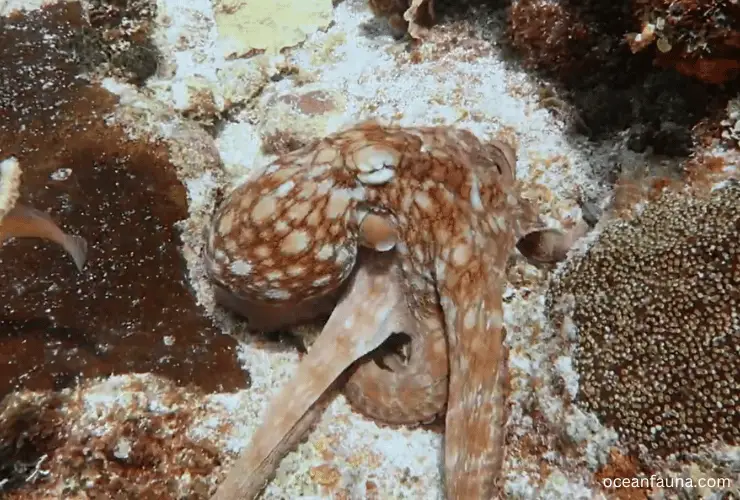
Let’s see what Wild Life Trusts organization describes its appearance:
“The common octopus boasts a flexible, sac-like physique, enabling it to wedge itself into tight spaces, either to evade predators or to conceal itself while hunting. Its physique has bumpy skin and adapts its hue based on its environment and emotions, usually appearing brownish-green in hue.” (Source)
3. Location
According to Atlantic study research, “the distribution range of the Common Octopus extends from the eastern Atlantic, including the Mediterranean Sea, the southern coast of England, down to the southern coast of South Africa. It is also found in the vicinity of the Azores, Canary Islands, and Cape Verde Islands. Additionally, it is prevalent in the Western Atlantic region.”
According to Marine Bio organization’s authors: (source)
“The common octopus is present globally, inhabiting both tropical and temperate aquatic regions. They are plentiful in the Mediterranean Sea, near Japan, and along the Eastern Atlantic’s coastlines at depths ranging from 1 to 200 meters.”
They further explained:
“The Octopus vulgaris species, or a complex of related species, can be found in a range of shallow nearshore waters to the edge of the continental shelf with depths between 0-200 m. There is a lack of precise definition of its taxonomic and geographic parameters, leading to speculation among scientists that it may actually be composed of several sister species.”
Marine Bio organization’s researchers have explained the following locations:
The species can be divided into various “types” based on their geographical distribution:
- Sensu stricto, found in the Mediterranean Sea and central to the north-east Atlantic Ocean
- Type I, found in the western central Atlantic Ocean including the Caribbean Sea and Gulf of Mexico, from South Carolina to Venezuela
- Type II, found off the coast of Brazil
- Type III, found in coastal waters from Luderitz on the west coast of Namibia to Durban in South Africa at the boundary with the tropical Indian Ocean
- Type IV, found in the coastal subtropical and temperate waters of the northwest Pacific Ocean.
Common octopuses occupy the sea floor and occupy various habitats, including coral reefs, sand areas, and seagrass beds. They require a physical structure as their home and can be found residing in rocks, debris, shells, sponges, coral, algae, seagrass, or human-made objects.
4. Evasive Behavior
Octopuses possess the capability of learning and can distinguish through visual, tactile, and chemical sensory inputs. Octopus vulgaris is known for keeping its dwelling place concealed and the females secure it by placing shells, rocks, and other collected solid objects around it, usually in a crevice or a secluded spot.
The common octopus possesses impressive swimming capabilities and can quickly propel itself forward by shooting out water from its body. Its flexible form enables it to fit into narrow spaces where predators cannot follow, as long as the gap is wider than its tough beak.
In dire situations, the octopus can detach an arm to break free from a predator’s grip and then regenerate the limb without any lasting harm. This species also boasts beak-like jaws and saliva that are venomous, mainly utilized to immobilize prey.
5. Habitat of common octopus
The Common Octopus is found in tropical, subtropical, and temperate waters worldwide. It inhabits shallow, rocky, coastal waters, typically no deeper than 200m. It thrives in a salinity range of 30-45 grams per liter. Their preferred temperature is 15-16°C, but they may seek deeper waters during warm seasons.
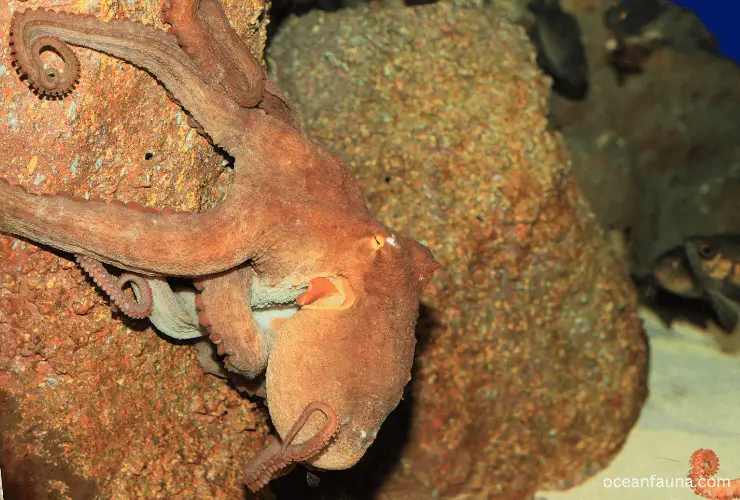
The octopus mostly hides in shelters, exposing little of its body to the water. When it moves, it crawls along the ocean floor, keeping its underside hidden. This movement raises its metabolic demands, requiring a 2.4 times increase in oxygen intake. The increase in oxygen demand is met by an increase in the heart’s stroke volume.
ICUN RedList organization has described its habitat and ecology in the following points: (source)
- The Common Octopus is a benthic species found in temperate, subtropical, and tropical waters with temperatures ranging from 6-33°C.
- It thrives in environments with salinity greater than 29 ppt and may undertake limited seasonal migrations.
- Its diet mainly consists of fish, crustaceans, and molluscs, but it may also feed on polychaete worms and ophiuroids.
- It is preyed upon by large fish such as conger and moray eels and marine mammals like common and bottlenose dolphins.
- The highest mortality occurs during its planktonic phase.
No conservation measures exist for the Common Octopus. Research is needed to assess the impact of harvesting and monitoring is necessary.
6. Diet / Feeding Habits of Common Octopus
Animal Diversity organization’s authors have talked about the feeding habits of common octopus:
“The Common Octopus feeds mainly on snails and clams. When they are young, they live in the plankton and hunt actively for several weeks before transitioning to a benthic lifestyle when they reach around 0.2 grams in size.” (Source)
Another study reported that,
“The common octopus is known to hunt at twilight, preferring to consume crabs, crayfish, and bivalve mollusks. However, it is adaptable and will consume almost any prey it can capture. The octopus can camouflage by changing its color to match its environment and is capable of suddenly attacking unsuspecting prey that crosses its path. With its powerful beak, it can even crack the shells of shelled mollusks.”
7. Reproduction system
Individuals of both male and female gender are present in Octopus vulgaris species. During mating, the male approaches the female, who initially resists him, but later agrees to mate.
He positions himself near or on top of her, inserting a specialized arm called hectocotylus into her mantle cavity to transfer spermatophores. Mating can go on for several hours and the same pair may repeatedly mate for a week or more.
Although a male can mate with other females, a female may also mate with other males. It’s typical for mating to occur when the female is not yet mature, with only those ready to lay eggs consistently rejecting advances from males.
Females become restless during mating season and search for a safe place to lay and protect their eggs. The spermatophores are fertilized in the oviductal glands as the eggs pass through. The eggs are then attached in strings to a substrate, using secretions and mucus from the oviductal glands.
These eggs are laid in shallow water and are always attached to a solid object, such as a rock, or a man-made object, like a can or tire. During the egg-laying and brooding period, the female rarely leaves the eggs and does not feed.
She continually cares for the eggs by cleaning them and pushing away intruders with jets of water from her funnel. The total number of eggs laid can range from 100,000 to 500,000. The female usually dies shortly after the eggs hatch and the young are born. (Source)
8. Intelligence
Common Octopus is extremely intelligent. Octopuses have an unusual brain structure compared to other animals, with most neurons distributed in their arms instead of the head. Despite this, they possess remarkable intelligence, with a brain size that is larger in proportion to their body size than most creatures, except birds and mammals.
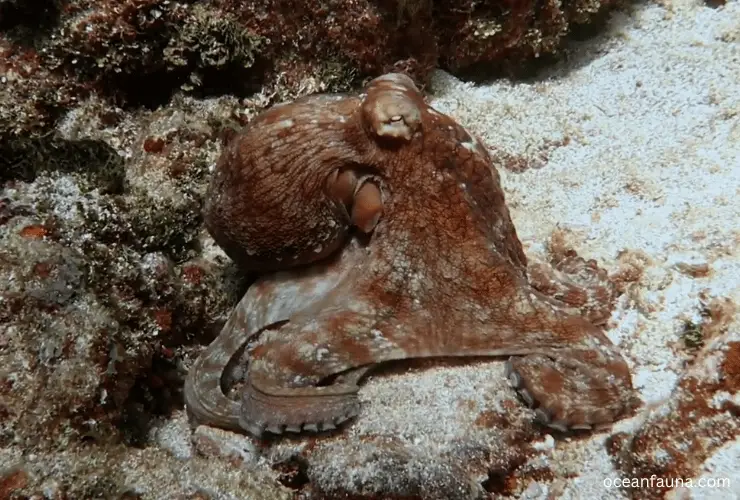
Common octopuses display high-level cognitive abilities such as tool use and problem-solving, even being able to open jars to access food. As a result of their intelligence and distinctiveness from humans, researchers are increasingly considering octopuses as a valuable model for understanding complex brain functions and novel neurological adaptations in cephalopods.
9. Cardiovascular and nervous system
The cardiovascular system of the common octopus is a complex and sophisticated network of vessels, hearts, and tissues. The octopus has three hearts that work together to regulate its blood flow and maintain proper circulation.
The two branchial hearts pump blood through the gills to extract oxygen from the water, while the systemic heart pumps blood throughout the rest of the body. The blood of the octopus contains hemocyanin, which is an iron-free oxygen-carrying molecule, allowing the octopus to thrive in low-oxygen environments.
The nervous system of the common octopus is also highly advanced. Octopuses have a decentralized nervous system, with most of their neurons distributed throughout their arms instead of being concentrated in the head.
They possess remarkable cognitive abilities, including problem-solving, tool use, and high-level learning and memory. Their brains have been found to contain high levels of plasticity and adaptability, allowing octopuses to learn quickly and adjust their behavior in response to changing circumstances.
Furthermore, octopuses can generate complex and coordinated movements with their eight arms, and they can respond quickly to changes in their environment, making them extremely versatile and highly responsive creatures.
10. Conservation Status
The ICUN has deemed the Common Octopus (Octopus vulgaris) as “Least Concern.” This is due to its widespread distribution in the Atlantic and some parts of the Pacific. Despite being fished in many areas with mostly no regulation, only certain locations have significant fishing pressure. (Source)
11. Predators of Common Octopus
The biggest predators of common octopuses are humans. It’s an interestingly amazing fun fact too. It is frequently caught for both food and the aquarium industry. Commercial fisheries harvest between 10,000 to 20,000 metric tons of common octopuses each year through the use of unbaited pots. These pots serve as deceptive shelters for unsuspecting octopuses. (Source)
Following are the countries/states where common octopus is consumptive more:
- Japan is a country that consumes a lot of octopus.
- In Asia, Korea also has a high consumption of octopus.
- Maldives and Mauritius are among the countries with a high intake of octopus.
- Greece, Spain, and Portugal in Europe have a significant consumption of octopus.
- Tunisia, Turkey also has a high intake of octopus.
- The United States also consumes a considerable amount of octopus.
National Wildlife Federation has also addressed the most common predators of the common octopus. They included the following:
- Moray eels
- Large Fish
- Dolphins
- Seals
- Sperm Whales
- Sea Otters
- Many Birds like eagles
- Other Octopuses
An octopus is hunted by many creatures that live in the sea. Let’s see what the Animals Answers Guide organization talks about its predators: (source)
- Dolphins: The New Scientist reports that it is common for bottlenose dolphins to consume common octopuses. These sea creatures provide a high-protein meal for dolphins. Octopuses tire easily during the pursuit, making it easier for dolphins to catch them. To kill an octopus, dolphins break its body and tentacles into smaller pieces by shaking it violently until it tears apart.
- Large Fish: Several sea creatures that consume common octopuses include large fish like sharks, moray eels, and conger eels. These animals are meat-eaters and will eat anything they can fit in their mouth.
- Seabirds: Seabirds, including petrels, penguins, seagulls, and albatross, consume octopuses. However, they are not a major component of their diet since many octopus species inhabit the deep sea. The most accessible type is the pelagic octopus, found near the surface of the water.
- Seals: Seals are meat-eaters and may consume common octopuses. Nevertheless, octopuses are not the most straightforward meal for seals to capture, consume, and digest. Fish is the primary food source for seals, yet they will eat any type of meat they can find in the water, including octopuses.
- Sea Otters: Sea otters consume different kinds of food, including common octopuses. California’s Monterey Bay sea otters are known to occasionally feed on giant Pacific octopuses, which are the largest and longest-living species of octopus.
- Sharks: Sharks, being the largest fish, prey on common octopuses. Common shark predators of octopuses include dogfish sharks, whitetip reef sharks, nurse sharks, and hammerhead sharks.
- Whales: Toothed whales such as sperm whales, white whales, and beaked whales primarily feed on the common octopus. Additionally, dolphins that were previously noted as octopus predators are also part of the whale family.
- Other Octopuses: It sounds creepy, but Lab studies show that octopuses prey on each other, making them some of the top predators in their species.
You are now informed of the primary and the most dominant predators that consume common octopuses in the sea.
National Geographic organization has defined an amazing mechanism in the following words:
“The octopus has a remarkable defense mechanism – its camouflage. Equipped with pigment cells and specific muscles, the common octopus can quickly adapt to its environment and blend in, making it invisible to predators such as sharks, eels, and dolphins. With this ability, it can evade detection and stay safe.” (Source)
12. Ink of Common Octopus
The ink of a common octopus is a dark, cloudy substance that it releases as a defense mechanism when it feels threatened. The ink serves to obscure the view of its attacker and contains a substance that dulls the predator’s sense of smell, making it more difficult for the predator to track the octopus as it swims away.
Let’s see what the researchers from the National Geographic organization say about it:
“The common octopus has an incredible defense mechanism, known as “ink”, that it releases when threatened by a predator. The ink creates a cloud that obstructs the attacker’s vision, providing the octopus with an opportunity to escape. Additionally, the ink contains a chemical that masks the octopus’s scent, making it difficult for the predator to follow.” (Source)
Is Common Octopus Venomous?
Yes, the common octopus is venomous. It boasts a secret weapon, possessing specialized salivary glands located in the buccal mass, and contains various enzymes, toxins, and other compounds that create venom to subdue its prey.
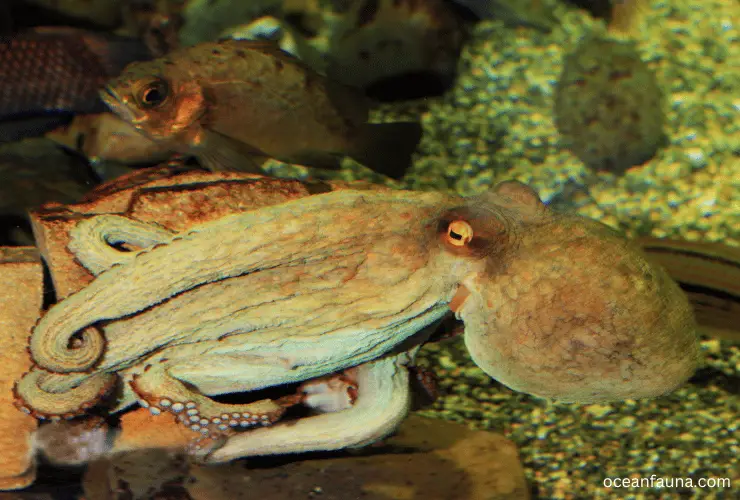
According to NCBI research, the venom of the common octopus is primarily used to paralyze its prey, which consists of small crustaceans, mollusks, and small fish. The venom contains a mixture of enzymes that break down the tissues of its prey, as well as compounds that can cause paralysis and numbness. This allows the octopus to easily capture and consume its prey without being injured in the process. (Source)
The venom of the common octopus is also used for self-defense. If the octopus is threatened, it can release a cloud of ink to confuse and distract its predator, giving the octopus time to escape. In some cases, the octopus may also bite its attacker, releasing a small amount of venom that can cause discomfort or pain.
It is important to note that the venom of the common octopus is not lethal to humans. Although a bite from an octopus can be painful, it is not considered to be a significant health risk. In most cases, the symptoms of an octopus bite can be managed with basic first aid and do not require medical treatment.
What Adaptations Do the Common Octopus Have?
The common octopus has the following adaptations:
- Inky escape: The common octopus is known for its ability to release a cloud of ink to confuse predators and escape danger.
- Camouflage: Octopuses can change their skin color and texture to blend in with their surroundings and avoid detection.
- Regeneration of lost arms: Common octopuses can regrow lost arms if they become detached in a struggle with a predator.
- Arm movement: Octopus arms are highly flexible and can move in a variety of directions, allowing them to manipulate objects and handle prey.
- Powerful suction cups: Octopuses have suction cups on the underside of their arms that they use to grasp and hold onto objects, including prey.
- Bilateral symmetry: Octopuses have bilateral symmetry, which allows for greater mobility and dexterity.
Fascinating Facts About Common Octopus
Did you know the following fascinating facts about common octopuses before?
- The female common octopus tends to her eggs with dedication, constantly guarding and providing fresh water to keep them alive through her funnel. Unfortunately, she usually passes away shortly after the eggs hatch.
- The common octopus has a unique ability to change its skin color and texture in a matter of seconds, which is called “skin-camo.” This adaptation allows the octopus to blend into its surroundings and avoid predators or ambush prey.
- Octopuses are expert escape artists and can quickly squeeze themselves through tight spaces. They can also detach their limbs to distract predators and grow new ones later on.
Frequently Asked Questions (FAQs)
Are common octopuses endangered?
According to the IUCN Red List, the Common Octopus is not considered endangered or threatened. However, it is widely consumed as food in Asian and Mediterranean cuisines. Octopuses are caught through trawling and by being lured into plastic traps. If overfishing or trawling coincides with their breeding season, octopus populations could be at risk. (Source)
How long does a common octopus live?
The common octopus has a lifespan of 1 to 2 years. They reach maturity after about 6 to 8 months and then lay eggs that take about 50 to 60 days to hatch.
How do common octopuses breathe?
Common octopuses have a simple circulatory system and breathe through gills located in their mantle cavity. The water they take in to breathe also helps regulate their body temperature.
How do common octopuses reproduce?
Common octopuses reproduce sexually, with the male and female mating by exchanging sperm packets. After mating, the female lays a large number of eggs and guards them until they hatch. After hatching, the young octopuses are on their own and must find food and avoid predators to survive.
Conclusion
In conclusion, the common octopus is a fascinating and intelligent creature that can adapt to its environment and use various tactics to avoid predators or catch prey. It is a remarkable creature that continues to amaze and inspire us with its incredible abilities.

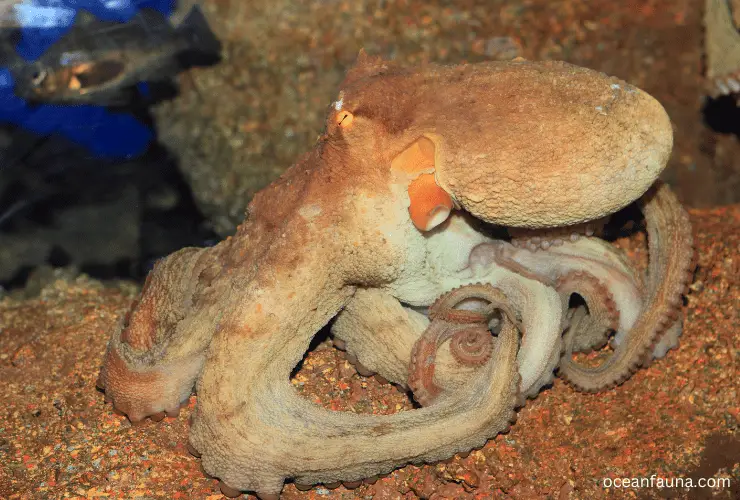
2 thoughts on “Common Octopus: Habitat, Description and Facts”